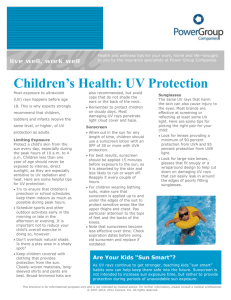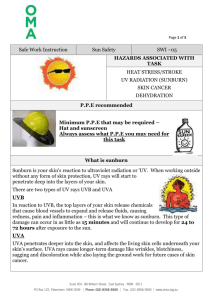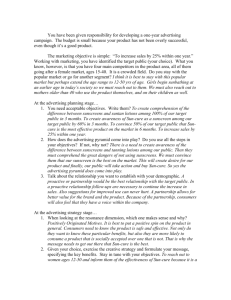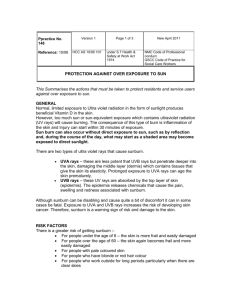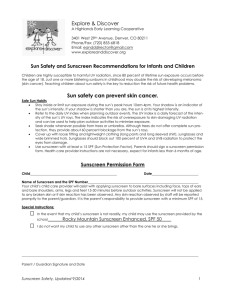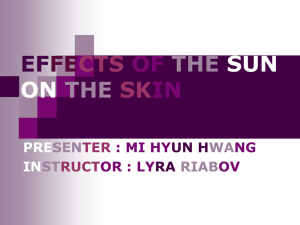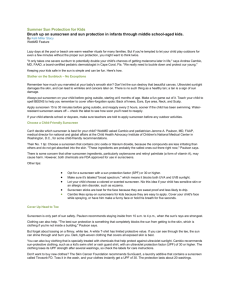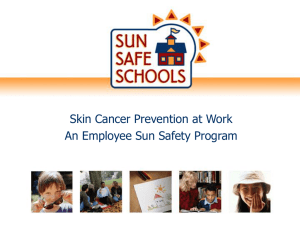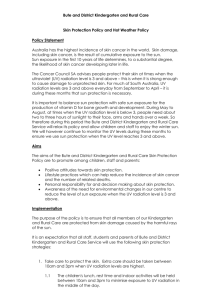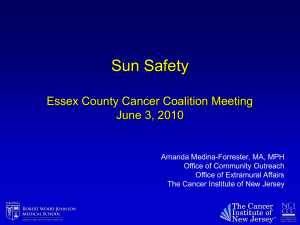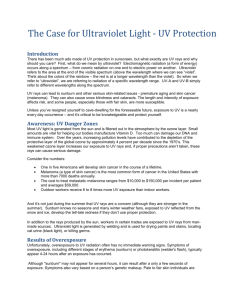Sun Safety Issues for Children in Day Care
advertisement
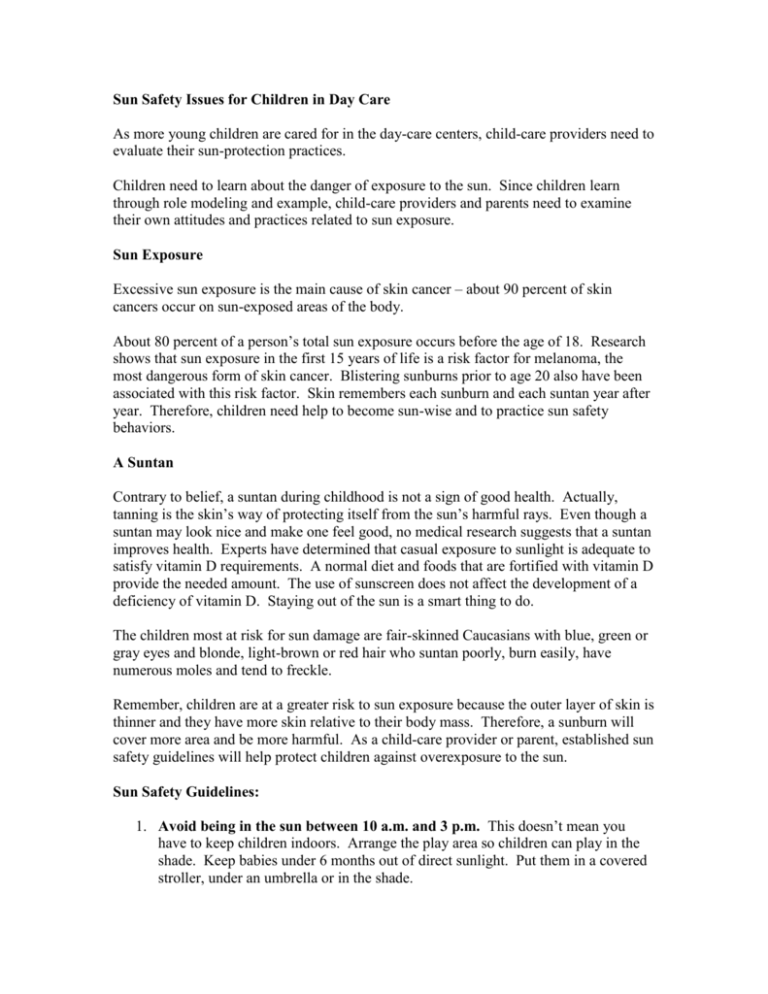
Sun Safety Issues for Children in Day Care As more young children are cared for in the day-care centers, child-care providers need to evaluate their sun-protection practices. Children need to learn about the danger of exposure to the sun. Since children learn through role modeling and example, child-care providers and parents need to examine their own attitudes and practices related to sun exposure. Sun Exposure Excessive sun exposure is the main cause of skin cancer – about 90 percent of skin cancers occur on sun-exposed areas of the body. About 80 percent of a person’s total sun exposure occurs before the age of 18. Research shows that sun exposure in the first 15 years of life is a risk factor for melanoma, the most dangerous form of skin cancer. Blistering sunburns prior to age 20 also have been associated with this risk factor. Skin remembers each sunburn and each suntan year after year. Therefore, children need help to become sun-wise and to practice sun safety behaviors. A Suntan Contrary to belief, a suntan during childhood is not a sign of good health. Actually, tanning is the skin’s way of protecting itself from the sun’s harmful rays. Even though a suntan may look nice and make one feel good, no medical research suggests that a suntan improves health. Experts have determined that casual exposure to sunlight is adequate to satisfy vitamin D requirements. A normal diet and foods that are fortified with vitamin D provide the needed amount. The use of sunscreen does not affect the development of a deficiency of vitamin D. Staying out of the sun is a smart thing to do. The children most at risk for sun damage are fair-skinned Caucasians with blue, green or gray eyes and blonde, light-brown or red hair who suntan poorly, burn easily, have numerous moles and tend to freckle. Remember, children are at a greater risk to sun exposure because the outer layer of skin is thinner and they have more skin relative to their body mass. Therefore, a sunburn will cover more area and be more harmful. As a child-care provider or parent, established sun safety guidelines will help protect children against overexposure to the sun. Sun Safety Guidelines: 1. Avoid being in the sun between 10 a.m. and 3 p.m. This doesn’t mean you have to keep children indoors. Arrange the play area so children can play in the shade. Keep babies under 6 months out of direct sunlight. Put them in a covered stroller, under an umbrella or in the shade. 2. Apply sunscreen that has an SPF (sun protection factor) of at least 15 or higher) To be effective, sunscreen must be applied to the skin 20 to 30 minutes before going outdoors and reapplied every two hours or after swimming or sweating. The sunscreen may be provided by the parents or by the day-care centers. Children should learn to make applying sunscreen a habit, like brushing their teeth. 3. Wear safe sunglasses. Babies and young children are more susceptible to irreversible solar eye damage. The eyes can be protected from ultraviolet rays by wearing lenses that absorb 100 percent of both UV-A and UV-B solar rays. 4. Wear protective clothing - a wide-brimmed hat, a long-sleeved shirt and pants. A hat shields the face, ears and back of the neck. A baseball hat does not provide adequate protection but is probably better than no hat at all. In most Australian schools, the “no hat, no play” rule is enforced at recess. A typical summer shirt has an SPF of about 6.5. Dense-weaves fabrics block out the sun’s rays. Research at the University of Nebraska found that washing cotton fabrics repeatedly in a detergent with brightening agents actually enhanced the fabrics’ sun protection levels. The sun-blocking abilities were assigned a UPF 9ultraviolet protection factor). A knit cotton T-shirt had a UPF rating that jumped from 6.5 to 38.4 after 20 washings. 5. Beware of cloudy days. As much as 80 percent of the sun’s rays come through clouds so apply sunscreen on those days, too. 6. Sand, snow, concrete and water can reflect up to 85 percent of the sun’s damaging rays. Take precautions near these surfaces. 7. Child-care providers and parents need to set a good example for children. A child’s sun exposure is dependent on the attitudes and practices of the primary caregiver. Parents and caregivers who frequently practice skin cancer prevention behaviors are more likely to practice prevention techniques with children. Children model what they see. 8. Practice sun protection year-round. A=Away. Stay away from the sun in the middle of the day. B=Block. Use sunscreen with an SPF of 15 or higher. C=Cover Up. Wear a T-shirt and a hat. S=Speak Out. Talk to your family and friends about sun protection. Day-care providers and parents need to understand the importance of sun safety practices in relation to the long-term incidence of skin cancer in the children they serve. Protection from the sun should be considered as necessary as providing a balanced diet. One study indicated that children who regularly use sunscreen with an SPF factor of 15 or more during the first 18 years of their lives can reduce the lifetime incidence of skin cancer by 78 percent. Sun safety can be taught to 4 and 5 year olds. Ii is important to increase their knowledge and comprehension, but they need help practicing sun safety. According to the Skin Cancer Foundation, “It takes years to get skin cancer and most of us get an early start.” Now is the time to teach and practice sun safety. Teaching sun safety early in life can truly save lives.
